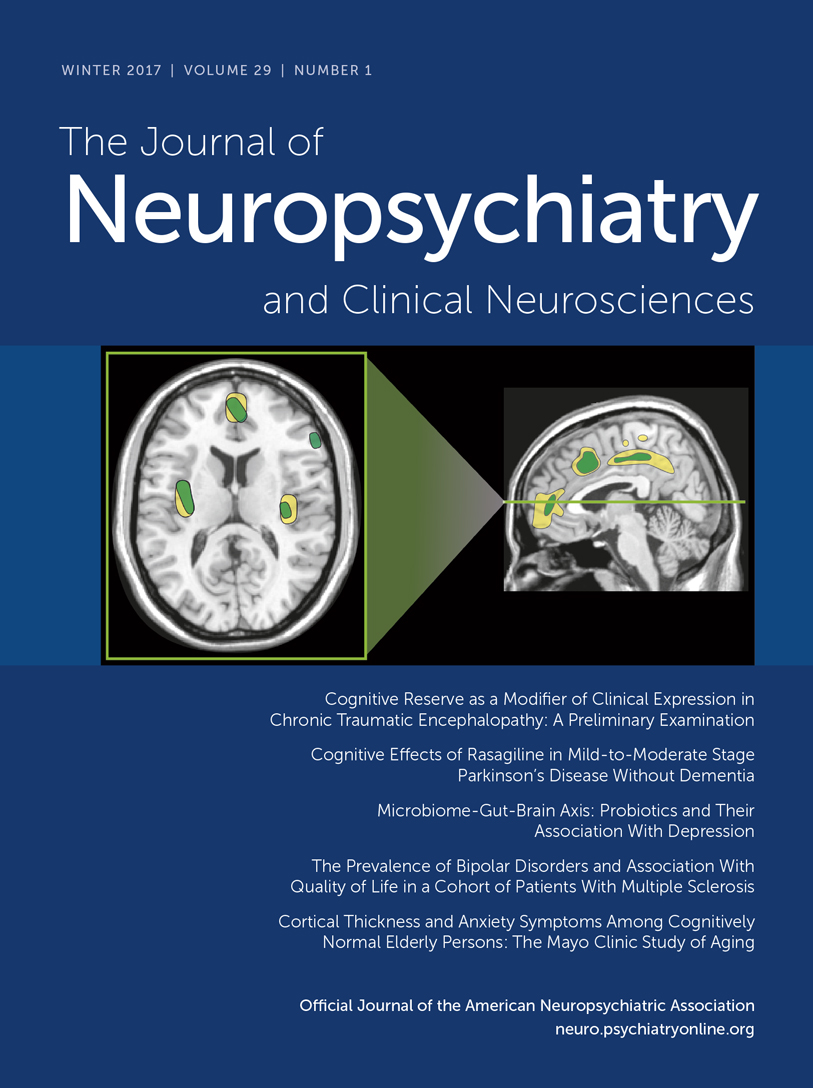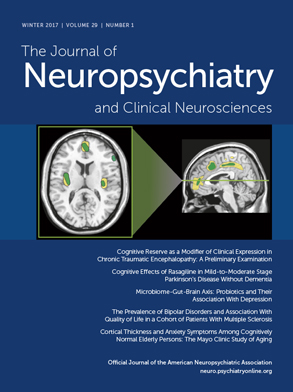Antibodies against onconeural intracellular antigens are serum markers of paraneoplastic syndromes and target antigens in tumors and neuroectodermal tissues. They are associated with various types of cancer and clinical syndromes.
1 Well-characterized onconeural antibodies include anti-Hu (ANNA-1), Ri (ANNA-2), Yo, CRMP5 (CV2), Ma1, Ma2 (Ta), amphiphysin, recoverin, Tr, and SOX1.
2 It is commonly held that these antibodies represent an epiphenomenon to cytotoxic T-cell reactions, although some studies have found evidence for their direct pathogenicity.
3,4Autoimmune neurological disorders, including limbic encephalitis, are associated with antibodies directed toward many different antigens. Several studies have addressed the relevance of antibodies targeting neuronal surface antigens (e.g., anti-N-methyl-
d-aspartate receptor, anti-LGI1) in psychiatric patients.
5,6 However, disorders associated with antibodies targeting intracellular antigens (e.g., anti-Hu, anti-Ma2) may also lead to prominent neuropsychiatric symptoms, such as irritability, hallucinations, depression, and personality disturbances.
7 Occasionally, psychiatric symptoms may be the main or only clinical feature.
8,9 These intracellular antigens are frequently of paraneoplastic origin.
1 However, it is unknown how prevalent these antibodies are in patients with acute psychiatric disorders. Several authors have recently called for studies addressing the role of onconeural antibodies targeting intracellular antigens in psychiatric patients.
10,11 To investigate this issue further, we examined the prevalence of onconeural antibodies in a large sample of patients admitted to an acute psychiatric center.
Methods
Setting
This study is a cross-sectional retrospective single-center study. Serum was drawn from 585 patients admitted acutely to a university psychiatric center with a catchment area of 140,000 inhabitants (St. Olavs University Hospital, Trondheim, Norway). Patients are referred to the center from other health care services (general practice, somatic hospital departments, etc.) The most common referral diagnoses include exacerbations of previously known psychiatric disorders (depression, bipolar disorder, schizophrenia spectrum disorders, personality disorders), suicidal ideation, and drug-related psychiatric symptoms. Patients with somatic diseases requiring critical medical care remain in medical and surgical departments and are managed on a consultant basis (and these patients were excluded from the present study population). Analysis of onconeural antibodies was performed in April 2014 at Euroimmun, Lübeck, Germany, as described below.
Patients
Between October 19, 2004, and November 11, 2006, 832 patients were admitted acutely to our psychiatric inpatient center. Blood samples and consent to participate in the study were available from 585 of these patients (inclusion rate: 70.3%). Patients were excluded from participation only if consent could not be obtained. There were no significant differences in age (p=0.72, Mann-Whitney U test) or gender (p=0.88, chi square) between the included and nonincluded patients. However, there was a difference in the diagnostic distribution between the groups that reached statistical significance (p=0.031, chi-square), attributable to overrepresentation of patients suffering from depressive disorders among the included patients.
Diagnostic Evaluation
Each patient underwent a diagnostic evaluation according to the ICD-10 research criteria. Final diagnoses were set in a consensus meeting with psychiatrists and psychologists, including at least two senior consultants. If multiple diagnoses were made, we registered the clinicians’ main psychiatric diagnosis.
Blood Samples
Blood was sampled between 7:00 a.m. and 10:00 a.m. the first day after admission. In six of the patients, blood was drawn at discharge. Blood was collected in serum gel tubes, centrifuged at 3,000 rpm for 5 minutes and stored at minus 80°C until analysis.
Serological Analysis
Serum was analyzed for the presence of antibodies (IgG, IgA, and IgM isotypes) to the following antigens: MOG, GLRA1B, DPPX, GRM1, GRM5, DNER, Yo, ZIC4, GAD67, amphiphysin, CV2, Hu, Ri, Ma2, and recoverin (by indirect immunofluorescence and immunoblot). We used biochip mosaics of frozen brain sections (rat, monkey) and transfected HEK293 cells expressing respective recombinant target antigens (Euroimmun, Lübeck, Germany), as described previously.
12 Samples were classified as positive or negative based on fluorescence intensity of the neuronal tissue and transfected cells in direct comparison with nontransfected cells and control samples. Samples staining transfected cells but not sections of neuronal tissue were regarded as negative. Samples showing reactivity to IgG antibodies on neuronal tissue were further tested with immunoblot (Euroimmun, Lübeck, Germany).
Ethics
The study was approved by the Regional Committee for Medical Research Ethics, Middle Norway and Norwegian Social Science Data Services, and registered at ClinicalTrials.gov (NCT00184418;
https://clinicaltrials.gov/ct2/show/NCT00184418). Data collection and analysis were performed according to the Declaration of Helsinki.
Results
General Patient Characteristics
The sample consisted of 585 patients (mean age: 40.8 years [SD=16.8], range: 17–94 years; 48.2% male). The most prevalent main diagnoses were affective disorders (F30–F39, 38.8%), schizophrenia spectrum disorders (F20–F29, 17.8%), and psychoactive substance use (F10–F19, 13.2%). There was a significant difference in age between the diagnostic groups (analysis of variance, p<0.0001), attributable to a higher mean age in patients with organic mental disorders (mean age: 56.6 years [SD=22.8]). There were no significant differences in the sex distribution between different diagnostic groups after correction for multiple testing.
Onconeural Autoantibody Prevalence
Serum from one patient (0.2%) was positive for antirecoverin IgG (titer: 1:100) and confirmed weak positive using immunoblot. This patient was a 44-year-old woman with an unspecified paranoid psychosis (ICD-10 diagnosis, F22.9). The patient had no history of autoimmune disorders, and no somatic disorders were diagnosed during the admission. Biochemical parameters tested during the admission (e.g., c-reactive protein, white blood cell count, thyroid function) were within normal range. Serum samples from all other patients were negative for onconeural autoantibodies.
Analytic Variances
Serum samples from 24 patients showed reactivity on transfected cells but not on neuronal tissue. These antibodies were as follows: 19 anti-Ma2 (7 IgG, 6 IgA, and 6 IgM), three anti-Yo (2 IgG and 1 IgA), and two anti-amphiphysin (2 IgG). All these samples were considered negative due to lack of reactivity on neuronal tissue.
Discussion
Several authors have recently called for prevalence studies on antibodies targeting intracellular onconeural antigens in psychiatric patients,
10,11 suggesting that these antibodies could contribute to the pathophysiology of some psychotic disorders. Our findings do not support this suggestion. The present sample included serum from 585 patients consecutively admitted to acute psychiatric inpatient care, of which 100 were given a diagnosis within the schizophrenia spectrum (F20–F29 in ICD 10). Serum from only one patient was weakly positive to antirecoverin; the remaining patients tested negative when tested on binding to neuronal tissue. Antirecoverin is an antibody associated with tumor-associated retinopathy.
13Using the same immunohistochemical analytical methods performed by the same laboratory used in our study (Euroimmun, Lübeck, Germany), Dahm et al.
6 also found a low prevalence of onconeural IgG autoantibodies in healthy individuals and in patients with schizophrenia, affective disorders, and personality disorders.
The present study is limited by the lack of a control group. Furthermore, no data exist on potential differences in disease severity in the patients excluded or not consenting to participate in the study. These data also do not clarify the frequency of serum onconeural antibodies among patients with acute psychiatric symptoms requiring admission to inpatient medical or neurological services. It could be hypothesized that in the latter group (in which delirium is a relatively common presentation) the prevalence of autoimmune antibodies (including onconeural) might be higher. Additionally, in order to be able to screen a large sample of patients in need of acute psychiatric care, we analyzed serum only and not CSF. However, compared with other studies of acute psychiatric inpatient care, the enrolment rate in our study was high (70.3%),
14,15 strengthening the representativeness of the present data.
To our knowledge, this is the first study addressing the prevalence of a large number of well-characterized onconeural intracellular autoantibodies in patients admitted to acute psychiatric inpatient care. We conclude that serum onconeural antibody positivity is rare among patients acutely admitted for inpatient psychiatric care, and routine screening is not likely to be clinically informative in most cases. Additional studies are needed to determine the frequency of onconeural antibody positivity using CSF studies in this population and to clarify both the clinical indicators and risk-benefit ratio of CSF onconeural antibody screening among acutely admitted psychiatric inpatients.

